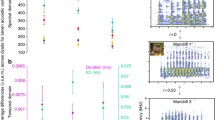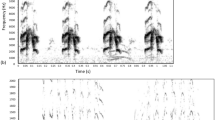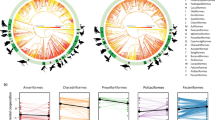Abstract
I develop the argument that for a true kin recognition system to evolve, selection must act on both parties: not only must recognition be favored in the donor of care, but reliable identification must be favored in the potential recipient of the care. This perspective suggests two complementary hypotheses, which I discuss and evaluate with data drawn from studies of birds. According to thesignature adaptation hypothesis, when the sender benefits by reliably identifying itself, selection will act directly on phenotypic characters so as to enhance their signature properties. I summarize our studies on parent-offspring recognition in four species of swallows which are consistent with this hypothesis. In particular, acoustical and perceptual analyses of chick calls show that the calls of colonial swallows are more individually distinctive than are the chick calls of noncolonial swallows. According to theantirecognition hypothesis, when the sender doesnot benefit by reliably identifying itself, selection will act so as to minimize signature characteristics. I suggest two contexts for research on this hypothesis. The first context occurs when parentage is uncertain due to extrapair copulations and/or egg-dumping, and the second context occurs when there is a long period between the onset of chick mobility and chick fledging, as occurs typically in gulls. In both instances, parents will be favored to recognize genetic relatedness of offspring but offspring will be favored to conceal it. To date, data from bird studies are consistent with the prediction that the interests of chicks win out in this situation.
Similar content being viewed by others
References
Baker, M. C., and Cunningham, M. A. (1985). The biology of bird song dialects.Behav. Brain Sci. 8:85–133.
Bateson, P. (1980). Optimal outbreeding and the development of sexual preferences in Japanese quail.Z. Tierpsychol. 53:231–244.
Bateson, P. (1982). Preferences for cousins in Japanese quail.Nature 295:236–237.
Bateson, P. (1983). Optimal outbreeding. In Bateson, P. (ed.),Mate Choice, Cambridge University Press, Cambridge, pp. 275–277.
Beecher, I. M., and Beecher, M. D. (1983). Sibling recognition in bank swallows.Z. Tierpsychol. 62:145–150.
Beecher, M. D. (1981). Development of parent-offspring recognition in birds. In Aslin, R. K., Alberts, J. R., and Petersen, M. R. (eds.),Development of Perception, Vol. 1, Academic Press, New York, pp. 45–66.
Beecher, M. D. (1982). Signature systems and kin recognition.Am. Zool. 22:477–490.
Beecher, M. D. (1988). Signalling systems for individual recognition: An information theory approach (submitted for publication).
Beecher, M. D., and Beecher, I. M. (1988). Parent-offspring recognition in the Northern rough-winged swallow (in preparation).
Beecher, M. D., and Stoddard, P. K. (1988). The role of bird song and calls in individual recognition: Field and laboratory perspectives. In Berkley, M., and Stebbins, W. C. (eds.),Comparative Perception, Wiley, New York (in press).
Beecher, M. D., Beecher, I. M., and Lumpkin, S. (1981a). Parent-offspring recognition in bank swallows. I. Natural history.Anim. Behav. 29:86–94.
Beecher, M. D., Beecher, I. M., and Hahn, S. (1981b). Parent-offspring recognition in bank swallows. II. Development and acoustic basis.Anim. Behav. 29:95–101.
Beecher, M. D., Stoddard, P. K., and Loesche, P. (1985). Recognition of parents' voices by young cliff swallows.Auk 102:600–605.
Beecher, M. D., Medvin, M. B., Stoddard, P. K., and Loesche, P. (1986). Acoustic adaptations for parent-offspring recognition in swallows.Exp. Biol. 45:179–193.
Beecher, M. D., Loesche, P., Stoddard, P. K., and Medvin, M. B. (1988). Individual recognition by voice in swallows: Signal or perceptual adaptation? In Hulse, S. H., and Dooling, R. J. (eds.),The Comparative Psychology of Complex Auditory Perception, Erlbaum, Hillsdale, N.J., (in press).
Beer, C. G. (1979). Vocal communication between laughing gull parents and chicks.Behaviour 70:118–146.
Brown, C. R. (1984). Laying eggs in a neighbor's nest: Benefits and costs of colonial living in swallows.Science 224:518–519.
Cullen, E. (1957). Adaptations in the kittiwake to cliff-nesting.Ibis 99:275–303.
Davies, S., and Carrick, R. (1962). On the ability of crested terns to recognize their own chicks.Aust. J. Zool. 10:171–177.
Gavin, T. A., and Bollinger, E. K. (1985). Multiple paternity in a territorial passerine: the bobolink.Auk 102:550–555.
Gowaty, P. A., and Karlin, A. A. (1984). Multiple maternity and paternity in single broods of apparently monogamous eastern bluebirds.Behav. Ecol. Sociobiol. 15:91–95.
Hamilton, W. D. (1964). The genetical evolution of social behaviour. I, II.J. Theor. Biol. 7:1–52.
Holley, A. J. F. (1984). Adoption, parent-chick recognition and maladaptation in the herring gull.Z. Tierpsychol. 64:9–14.
Holmes, W. G., and Sherman, P. W. (1982). The ontogeny of kin recognition in two species of ground squirrels.Am. Zool. 22:491–517.
Holmes, W. G., and Sherman, P. W. (1983). Kin recognition in animals.Am. Sci. 71:46–55.
Hoogland, J. L., and Sherman, P. W. (1976). Advantages and disadvantages of bank swallow coloniality.Ecol. Monogr. 32:33–58.
Jouventin, P. (1982).Visual and Vocal Signals in Penguins, Their Evolution and Adaptive Characters, Verlag Paul Parey, Berlin.
Loesche, P., Stoddard, P. K., Higgins, B. J., and Beecher, M. D. (1988). Perception of swallow calls by barn swallows and cliff swallows (in preparation).
Martin, R. F. (1980). Analysis of hybridization between the Hirundinid generaHirundo andPetrochelidon in Texas.Auk 97:148–159.
Mayr, E., and Bond, J. (1942). Notes on the generic classification of the swallows, Hirundinidae.Ibis 85:335–341.
McGregor, P. K., and Krebs, J. R. (1982). Mating and song types in the great tit.Nature 297:60–61.
Medvin, M. B., and Beecher, M. D. (1986). Parent-offspring recognition in the barn swallow.Anim. Behav. 34:1627–1639.
Medvin, M. B., Stoddard, P. K., and Beecher, M. D. (1988). Information analysis of the calls of cliff swallows and barn swallows (in preparation).
Shannon, C. E., and Weaver, W. (1949).The Mathematical Theory of Communication, University of Illinois, Urbana.
Shields, W. M. (1983). Optimal inbreeding and the evolution of philopatry. In Swingland, I. R., and Greenwood, P. J. (eds.),The Ecology of Animal Movement, Clarendon Press, Oxford, pp. 132–159.
Shugart, G. W. (1988). Parent-offspring recognition in gulls (in preparation).
Sokal, R. R., and Rohlf, F. J. (1981).Biometry, 2nd ed., Freeman, San Francisco.
Spurr, E. B. (1975). Misbehavior of the adelie penguin chick.Condor 77:272–280.
Stebbins, W. C. (1970).Animal Psychophysics, Appleton-Century-Crofts, New York.
Stoddard, P. K., and Beecher, M. D. (1983). Parental recognition of offspring in the cliff swallow.Auk 100:795–799.
Thompson, D. H. (1981). Feeding chases in the adelie penguin. InTerrestrial biology III. Antarctic Research Series 30, Amer. Geophys. Union, Washington, D.C.
Waldman, B., and Bateson, P. (1988). Kin association in Japanese quail chicks.Ethology (in press).
Westneat, D. F. (1987). Extra-pair fertilizations in a predominantly monogamous bird: Genetic evidence.Anim. Behav. 35:877–886.
Author information
Authors and Affiliations
Additional information
This work was supported in part by grants from the National Science Foundation.
Rights and permissions
About this article
Cite this article
Beecher, M.D. Kin recognition in birds. Behav Genet 18, 465–482 (1988). https://doi.org/10.1007/BF01065515
Issue Date:
DOI: https://doi.org/10.1007/BF01065515




